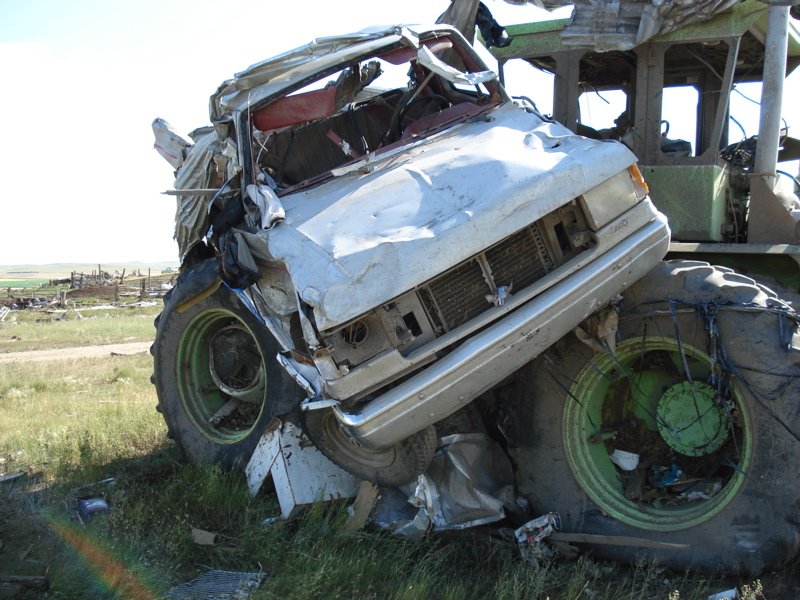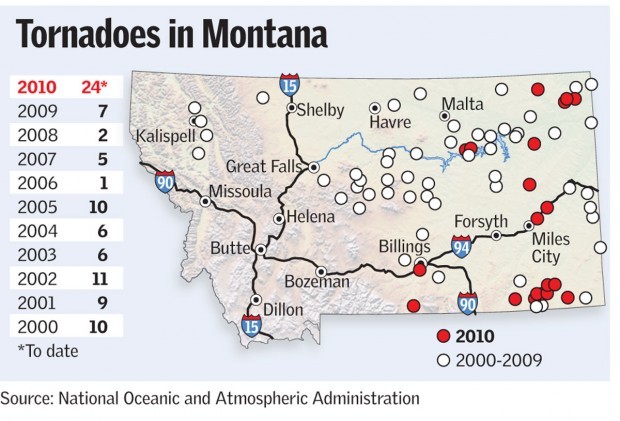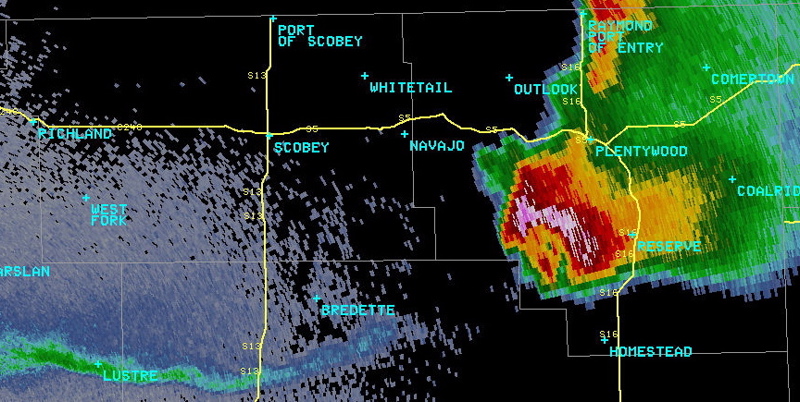|
Montana Tornadoes Were Frequent and Powerful in 2010
 Photo Courtesy of Tanja Fransen, National Weather Service
July 26, 2010 . . .
The damage shown in the photo above was caused by the same tornado that killed a 46 year-old man and a 10 year-old boy, injuring the boy's grandmother at the Smith Ranch in northeastern Montana on July 26, 2010. The deadly twister was one of the most powerful ever recorded in the state and the deadliest since 1923, when two men were killed by an F-1 tornado between Missoula and Superior. The tornado that decimated the Smith Ranch had winds that reached 150 miles/hour, making it only the fourth EF-3 tornado ever recorded in Montana, and the first since 1988.
The tornado, which traveled at about 30 miles/hour, was on the ground for 18 miles, demolishing power lines, a bridge and an abandoned house along its path. When it hit the ranch several miles northwest of Medicine Lake, its swath of destruction was .3 miles wide. The twister ripped the house off its foundation and destroyed everything, blowing away grain bins and throwing vehicles over a quarter of a mile. Cattle (both dead and alive) were found more than a mile away, and debris from the ranch was seen 2-3 miles away. CLICK HERE to see before and after photos of the ranch.
 One for the record books One for the record books
Tornadoes in Montana during 2010 were more numerous and more intense than any season over the past decade. This map from The Billings Gazette, shows how the first 7 months of 2010 compared to previous tornado seasons. Red dots on the map mark the location of the 2010 twisters through the end of July. Although Montana averages only 7 tornadoes per year, there had already been 24 during the first 7 months of 2010.
Why so many?
According to Dan Borsum, senior meteorologist at the National Weather Service Forecast Office in Billings, one possible reason for the high number might have been high humidity levels caused by heavy rains that the region experienced in June. "The amount of moisture that we've had is allowing us to stay in a thunderstorm pattern much later in the year, and that's allowing us to have more intense storms," Borsum said. In more humid parts of the country, tornadoes can form along cold fronts where cool air pushes into hot, humid air. Typically, air in Montana is dry, but this year has been an exception.
The 2010 tornadoes were stronger that usual as well. Tornadoes are considered to be strong if they are rated between EF-2 and EF-5 on the Enhanced Fujita Scale. On average Montana gets only one strong tornado per year. But, that number has more than tripled this year with the twisters reported in June and July. CLICK HERE to see how experts determine the EF rating based on damage. Select "Launch Interactive" when you get to the site. Try this fun interactive.
Billings tornado . . .
On Fathers' Day 2010 a tornado tore the roof off the Rimrock Auto Arena in Billings (a.k.a. The Metra), which plays host to many of the state's largest spectator events, including basketball tournaments, the state wrestling tournament, rodeos, hockey games, arena football games, concerts, and others. The tornado featured winds up to 120 mph, earning it an EF-2 rating. During the 12 minutes it was on the ground, its swath of destruction was about 120 yards wide and half a mile long. There were no fatalities caused by this tornado.
CLICK HERE to watch a news video of the Father's Day Tornado.
A really bad sign . . .
The National Weather Service's RADAR device in Glasgow recorded the image below at 7:31 pm on July 26, 2010; about the same time that the tornado ripped through the Smith Ranch, causing the two fatalities. The image shows precipitation intensity with the white, pink, and red colors being locations where the most intense rain and/or hail was happening. More importantly, the image showed that the intense precipitation was happening in a distinct hook-shaped pattern (called a hook echo); a clear sign that the thunderstorm was rotating. Meteorologists knew that this rotation meant it was very likely that a tornado was present beneath the storm.

Term: mesocyclone, supercell, Enhanced Fujita Scale
|



